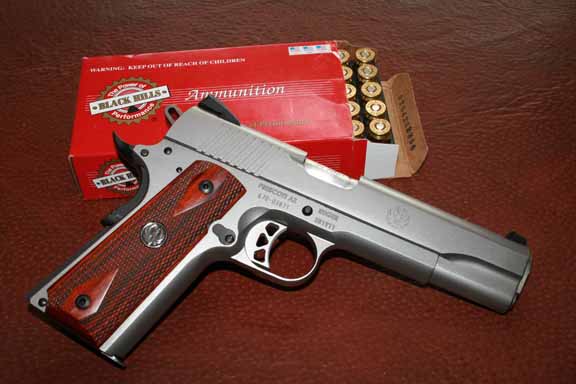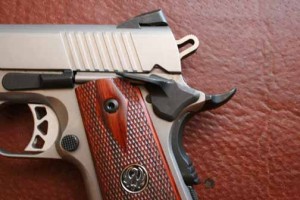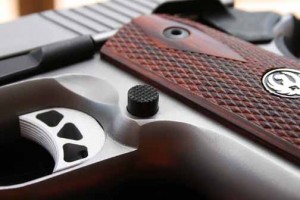Latest Updates and Reviews on Ruger Sr 1911

November 07, 2011

The 1911 wave has been ridden past a number of manufacturers, and so many variations accept been fabricated over the past 100 years that it seems unlikely that in that location would be room for whatsoever more. Fortunately for 1911 fans, Ruger doesn't go forth with that theory.
The company recently jumped into the 1911 market place with its SR1911. Ruger has long been known for the manufacture of tough, reliable and reasonably priced firearms. Its previous offerings in the automobile pistol marketplace have been excellent double-activity and striker-fired models, and the addition of a 1911 is the perfect way to round out its all-encompassing handgun lineup.
Ane complaint I've heard over the years about Ruger handguns has been that though they're well-congenital, some models are perceived as unattractive. Prior to the company actually unveiling its 1911, there was some worry in certain circles that Ruger would bring a lack of style sense to its take on John Browning's pattern.
The outset time I handled the Ruger SR1911, it was quite clear this was not the example. It was immediately apparent, in fact, that the SR1911 very well may be one of the most handsome Ruger handguns I've seen to date.

The full five-inch pistol bears a groovy finish—bead-blasted stainless steel slide and frame. The components are matte black, which, in combination with nice checkered wood stocks, make the gun a striking piece.
Ruger outdid itself with the grips on this pistol. The grips on my test gun had a squeamish figure to them and excellent checkering in the quondam diamond design. They conduct the Ruger emblem embedded on both sides.
As I mentioned, the pistol'southward components, including the slide stop, thumb safety, magazine release and beavertail grip safety are finished in matte black. These parts are manufactured using metal injection molding, which is a procedure that uses powdered metallic, forth with a binder, that is injected into a mold. The binder is then melted out, resulting in a function that is dimensionally correct and metallurgically as potent as a wrought role.
The pistol's mainspring housing is as well matte black, and checkered. The mag release and thumb safety are slightly extended, and the pollex safety isn't ambidextrous, which I prefer. The Commander-style hammer has an interesting finish—it'southward actually two-tone, with stainless sides and black matte and the back and top, covering the serrations.
The meat of the SR1911 is the stainless steel slide and frame. The slide is forged, and the frame is cast using Ruger's time-honored investment casting system. They are then precision machined for a tight slide-to-frame fit. My test gun had a very tight slide-to-frame lucifer, and sideways play betwixt the 2 was minimal.
The SR1911 features several accuracy-inducing details, not the least of which is the fact the barrel and bushing are fabricated from the same slice of ordnance-grade bar stock. Once the 2 pieces are made, they are kept together instead of mixed and matched. This ensures a precise fit and improved accuracy. Another interesting and unique detail is that the pistol's plunger housing is cast integrally. This prevents the loosening of the housing from the frame, which can obviously be a trouble.

At that place'southward been a good deal of debate over the years regarding Colt's Serial lxx versus the Series eighty 1911 pistols. The 1911 design remained basically the same from the inception of the pistol until 1970 when Colt instituted changes in the pistol's bushing design in an attempt to improve accurateness. These were the MK IVSeries 70 pistols.
In 1983, the company made significant blueprint changes internally. The MK 4 Series eighty guns employed a new firing pin cake safety system. The blueprint used internal levers and a plunger to positively block the firing pin, the cake deactivating when the trigger is pressed.
The purpose of this new design was to prevent the gun from discharging if were dropped on a difficult surface. The objection to the Series eighty firing pin safety organization amid many shooters was the idea that the activity couldn't be fine tuned considering of the levers and plunger, especially if one wished to strop the trigger to a light activity nether iii pounds. I've never worked on a Series 80 pistol, but I'thousand told that indeed a skilful gunsmith tin can smooth the action on i, though it's a bit more than time consuming.
Many of today's 1911 pistols still utilize the Series eighty firing pivot safety design. Ruger was able avoid this organisation past incorporating a titanium firing pivot and a heavy firing pin spring. Ruger says this method negates the demand for a firing pin cake, offering an updated safe feature to the original Series 70 design without compromising trigger pull weight. The combination of the lightweight firing pin and heavy spring eliminates the possibility of an inertia firing.
The trigger itself is relatively crisp—merely under five pounds according to my RCBS trigger pull scale. The trigger itself is skeletonized aluminum, and is adjustable for overtravel.
Ruger has long been addicted of paw forging its barrels, but the SR1911's is not forged since the integral feed ramp would accept chosen for a large forging blank. The barrels are broached using 410 stainless steel.
The SR1911 comes standard with the Novak three-dot sight organization. They are fitted into a dovetail slot and locked in with a pocket-size set screw. The rear sight is adjustable for windage. While I'm a fan of Novak sights, I'g not peculiarly a fan of the three white dot system. It's personal preference, but I similar black sights or certain night sight combos. I discover it very hard, especially when shooting for accuracy, to become a good sight picture with the white dots. I'm hoping Ruger will offer other sight options in the future.
While the SR1911 aesthetically is an outstanding rendition of Browning'southward original 1911 pistol, the obvious question is how does information technology actually perform? I took the Ruger out to my desert range on a hot afternoon with several brands of manufacturing plant .45 ACP ammunition for workout. I started out with Black Hills 230-grain jacketed hollowpoints, running a number of magazines through the gun. I picked various targets at various distances, getting familiar with the feel and trigger pull. The Ruger proved to handle easily, and I had little difficulty busting dirt clods and aluminum cans at ranges out to thirty yards offhand. The gun also performed quite well on the 25-yard accuracy test.
The SR1911 functioned very well using the several varieties of manufacturing plant ammunition I had on hand. I experienced ii failures to feed, both using the Black Hill 230-grain jacketed hollowpoint ammunition. The hollowpoints take a particularly wide mouth, and I think that's what casued the failures. I doubtable a little extra polishing of the feed ramp would remedy this problem for anyone wishing to use this load extensively.
I believe the SR1911 is going to be a great success for Ruger. With a retail price of merely under $800, information technology's an outstanding value. Anyone looking for a well-fabricated, well-finished 1911 pistol at a price that won't leave them eating frijoles for a calendar month should look no farther than the SR1911.
Fast Specs
- Type: 1911 semiauto
- Caliber: .45 ACP
- Barrel: 5 in. stainless 6-groove
- OAL/Width/Elevation: 8.67/one.34/v.45 in.
- Weight: 39 oz.
- Construction: low-glare stainless steel slide and frame
- Trigger: unmarried action, 5 lb. pull
- Sights: fixed Novak 3-dot
- Safeties: grip, thumb
- Price: $799
- Manufacturer: Ruger
Accurateness Results
- Smallest avg. group: 230 gr. Black Hills JPH +P—2.0 in.
- Largest avg. grouping: 230 gr. Hornady TAP—3.5 in.
- Avg. of all ammo tested (five types)—3.0 in.
- Accuracy results are averages of three iii-shot groups fired at 25 yards from a sandbag remainder.
Source: https://www.handgunsmag.com/editorial/review-ruger-sr-1911/138259
0 Response to "Latest Updates and Reviews on Ruger Sr 1911"
Post a Comment